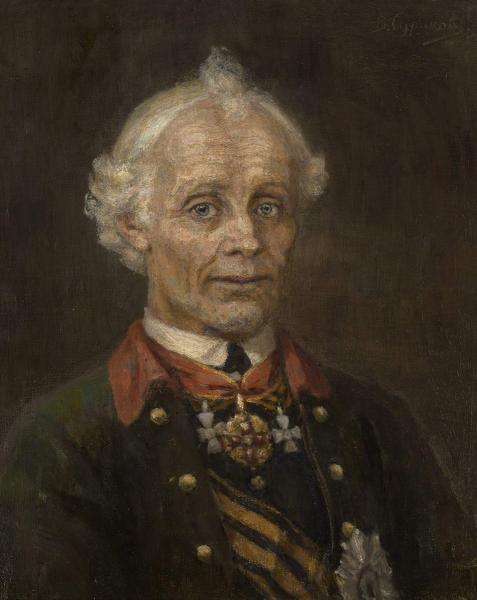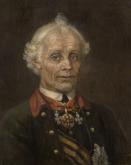Portrait of Generalissimo Alexander Suvorov
1907
- oil on canvas mounted on cardboard. 54 х 44
- Ж-4248
Received in 1940
Generalissimo A. V. Suvorov (1729–1800) was born in Moscow in the family of a warrant officer of the Preobrazhensky life guards regiment Vasily Ivanovich Surikov who later became a general in chief and a senator. A.S. Suvorov started his military services as a soldier in the Semenovsky life guards regiment. In 1754 he became a lieutenant, and from 1770 to 1794 acquired all ranks and titled from a general major to a general field marshal. He participated in the Seven Years’ War (1756–1761) and the war with Polish confederates (1769–1772). In the first Russo-Turkish War (1768–1774) he claimed a victory in the battles of Turtukay (1773) and Kozludzha (1774). In the second Russo-Turkish War (1787–1792) he became renowned for his victories in the battles of Fokshany and Rymnik (1789), as well as for carrying the fortress of Izmail (1790). In 1789 he was awarded with the title of the count of Rymnik, and in 1794 – with the highest military rank of general field marshal for the taking of Warsaw. In 1799 at the head of a confederate army of Russia and Austria he liberated Italy from the French occupation (and was victorious in the battles of Adde, Trebbia, and Novi) and completed his famous crossing of the Alps. After the Italian campaign Suvorov was awarded with princedom (the Prince of Italy) and a title of a generalissimo.
In the end of the 18th century two key figures, members of the Malthusian Order emerged in the Russian history – commander A.V. Suvorov and Emperor Paul I. In 1799 Paul I ordered to erect a memorial to Suvorov to commemorate his achievements, though the commander was still alive. Despite the disfavor of the Emperor that Suvorov faced during his last years, the works on the memorial were not stopped, and on May 5, 1881, after Paul’s death, the monument was erected on the Field of Mars. During the reign of Emperor Alexander I the memorial was moved to the square between the Marble Palace and the house of count Saltykov (today – Suvorov Square). The Italian-Swiss campaign was the highlight of Suvorov’s career in military command. In 1799 the whole Europe applauded to him, but no triumph was waiting for him in Russia. On his way from Prague Suvorov learned that no solemn festivities to greet the victor were planned, and that he was even prohibited to enter the capital during the day. He came to St. Petersburg at night in a common coach instead of a caroche, he was banned from the Winter Palace, his name was removed from all newspapers, and his favourite aides-de-camp were taken from him. On May 6, 1800 A.V. Suvorov died and was buried not as a generalissimo, but as a field marshal. Modern biographers still keep studying the reasons for the discord between the two great historical figures.

